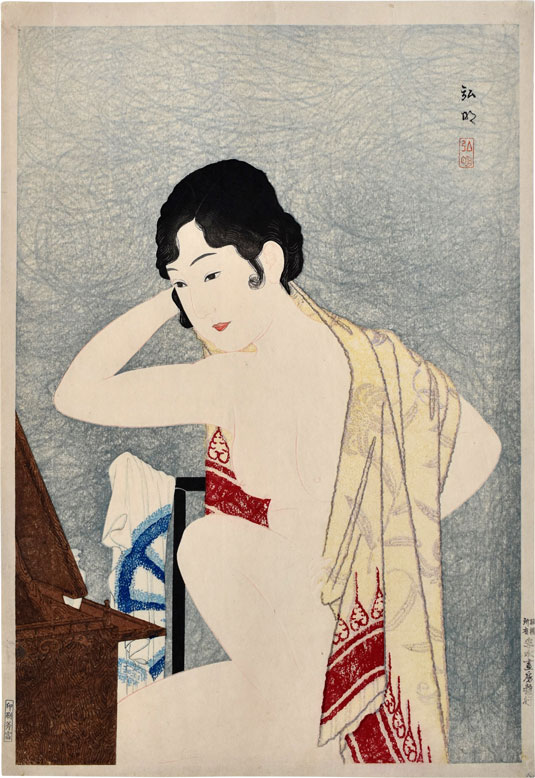

Takahashi Shotei (Hiroaki)
1871-1945
Make-up before the mirror (moga)
(Kagami no mae- Kesho)
with karazuri (blind-printing) to accentuate the curves the body, signed Hiroaki with artist's rectangular seal, Hiroaki, and publisher's seal on the lower right margin, Hanken shoyu Fusui Gabo hakko, with printer's seal on lower left, Insetsu Onotomi (printer Onotomi), ca. 1929-30
dai oban tate-e 16 1/4 by 11 1/8 in., 41.2 by 28.3 cm
This particular design falls within a subset of bijin-ga depicting women displaying the fashions and attributes of moga (shortened from modan garu, 'modern girl'). The most recognizable (and controversial) identifying characteristic of a moga was the bobbed haircut (or sometimes long hair was fashioned into a knot at the nape of the neck which would mimic the bob). The prototypical moga was an educated and independent woman, probably employed, and usually at least perceived of as promiscuous (if not actually so).
From the 1920s into the early 1930s Japanese women began to assert themselves beyond the strict ideals of their traditional roles as good daughters, wives and mothers. Many print artists approached the subject of moga as a fresh opportunity to depict bijin and their fashions; but some compositions also managed to convey temporal pleasures in the moga lifestyle. Appropriately, the decadence of enjoying the here and now of a fleeting, floating world is actually the very nature of ukiyo-e itself.
References:
Kendall H. BrownLight in Darkness: Woman in Japanese Prints of Early Showa (1926-1945), 1996, cat. 9
Amy Reigle Newland and Hamanaka Shinji, The Female Image: 20th century prints of Japanese beauties, 2000, no. 149
Nihon no hanga III 1921-1930, Toshi to onna to hikari to kage to (Japanese Prints III, 1921-1930: Cities and Women, Lights and Shadows), Chiba City Museum of Art, 2001, p. 125, no. 271
Amy Reigle Newland, gen. ed., Printed to Perfection: Twentieth-century Japanese Prints from the Robert O. Muller Collection, 2004, no. 14
Shimizu Hisao , Syotei (Hiroaki) Takahashi: His Life and Works, 2005, p. 68, no. 318
(inv. no. 10-4972)
price: Sold






